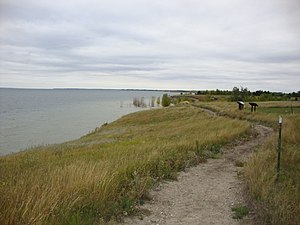Fort Stevenson State Park
|
Fort Stevenson State Park
|
||
|
Lakeside of Lake Sakakawea in Fort Stevenson State Park |
||
| location | McLean County in North Dakota (USA) | |
| surface | 222 ha | |
| Geographical location | 47 ° 35 ' N , 101 ° 25' W | |
|
|
||
| Setup date | 1974 | |
| administration | North Dakota Parks and Recreation Dept. | |
The Fort Stevenson State Park is a 222 hectare State Park in McLean County in the US state of North Dakota . It is three miles south of Garrison on the north shore of Lake Sakakawea .
investment
The park has a visitor center, a campsite with 145 spaces, as well as boat ramps and moorings. In a replica of the guardhouse of the former Stevenson Fort, built in 2003, there is a small exhibition on the history of the fort.
Flora and fauna
Most of the park was previously used for agriculture, so that only small remnants of the original prairie vegetation have been preserved. An arboretum with 50 different trees, shrubs, flowers and grass species has been created near the campsite . There are two rare species of animals in the park, the yellow-footed plover and the black-tailed prairie dog .
activities
The park is particularly popular with anglers who fish for the 35 different species of fish in Lake Sakakawea. The best known fishing fish is the eyeglass , which is why the park is also known as North Dakota's Walleye Capital . The Governor's Cup Walleye Fishing Derby has been held in the park every year since 1976 .
history
The park was named after Fort Stevenson, a 19th century military post. The fort was built in 1867 and named after Thomas Greeley Stevenson , a Union Army general who died on May 10, 1864 at the Battle of Spotsylvania Court House . The fort was used to secure shipping on the Missouri , to protect against Indians and as a base for various postal routes. It was also used to supply the Totten Fort 200 kilometers to the east . The fort consisted of ten primitive barracks made of adobe and poplar wood. It was not involved in any direct military action and was abandoned on August 31, 1883. The buildings served as an Indian school until 1894. The site of the former fort is now about three kilometers southwest of the park in the water of Lake Sakakawea.

